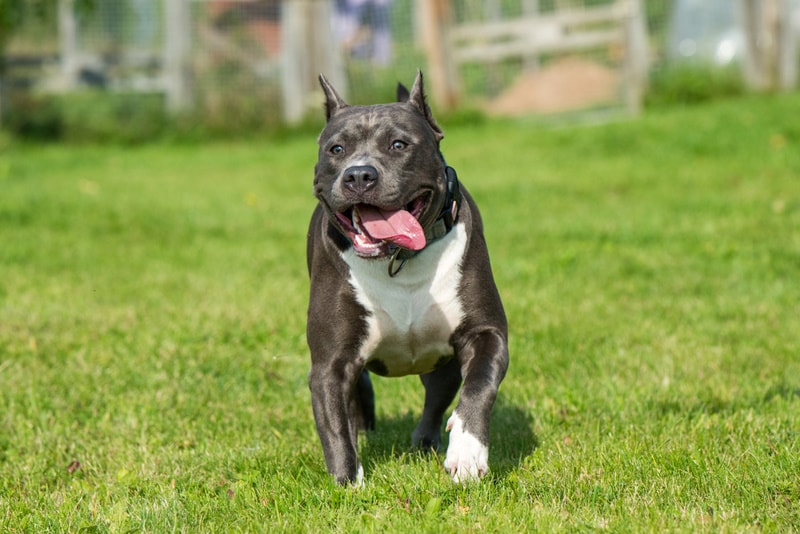Bull Terriers are medium-sized, muscular, strong, and fast dogs. They are considered a tough, brave, bold, and lively breed. As cute as they are, though, they can also be irritable, stubborn, noisy, and independent.
This breed can become possessive with their food and toys if they are not well socialized, even reacting aggressively. That said, they are generally friendly with people, especially children, if they have been socialized from a young age.
Bull Terriers are generally healthy, but like any other breed, they can have certain health problems.
The 7 Main Bull Terrier Health Issues
1. Hereditary Nephritis
Hereditary nephritis is an inherited disease that causes kidney failure at varying ages (especially in puppyhood) in Bull Terriers. The disease is characterized by the existence of small and underdeveloped kidneys, but it can also occur due to a malformation at the level of kidney filtration.
- Hematuria (blood in urine)
- Poor appetite
- Vomiting
- Weight loss
- Excessive thirst and urination
- Lethargy
- Protein in the urine
- Anemia
Hereditary nephritis has no cure, and Bull Terriers suffering from this condition usually die before they reach the age of 3. However, there are individuals that manage to live up to 6–8 years before developing kidney failure.
Hereditary nephritis of Bull Terriers is similar and represents a model for the autosomal dominant Alport syndrome in humans.

2. Renal Dysplasia
Renal dysplasia, or progressive juvenile nephropathy, is a condition that can affect one or both kidneys in young Bull Terriers. Specifically, nephrons develop abnormally inside the kidneys. The nephron is the structural and functional unit of the kidney. The severity of the condition depends on how many nephrons developed abnormally. The condition can be hereditary (genetic) or acquired, and the clinical signs occur when the dog is a puppy.
This disease often has no clinical signs until renal failure occurs. The initial signs include excessive thirst and excessive urination. As the disease progresses and the dog develops kidney failure, the following clinical signs may appear:
- Vomiting
- Low appetite
- Weight loss
- Lethargy
- Muscle weakness
- Diluted urine
- Poor coat
- Secondary urinary infections
Renal dysplasia has no cure and is potentially fatal.
3. Deafness
Deafness can affect both colored and white Bull Terriers and occur in one or both ears. Around 18% of white Bull Terriers are born deaf. It is recommended to avoid the reproduction of deaf animals, but there are always individuals that are simply born deaf.
Before adopting a Bull Terrier, make sure the breeder has done the BAER test at the age of 5 weeks. This is the only test that can determine deafness and its severity in Bull Terriers.
- The puppy does not respond to sounds.
- They do not react when called.
- They have difficulties with auditory cues.
Deafness has no cure, though quality-of-life treatments are available.

4. Heart Disease
Common heart diseases in Bull Terriers are aortic stenosis and mitral valve dysplasia.
Aortic Stenosis
Aortic stenosis is a common congenital heart defect in dogs. This condition is manifested by the narrowing of the aorta, the main vessel that carries blood from the heart to the entire body. In aortic stenosis, the blood that flows from the heart to the body is reduced.
Clinical signs vary depending on the degree of stenosis, the age of the dog, and changes in cardiac function. In severe forms, clinical signs of cardiac stenosis can be seen from the age of 5–6 months. Conversely, moderate forms can be tolerated for several years.
The clinical signs are generally those of left heart failure and include fatigue on exertion, syncope (fainting), coughing, difficulty breathing, etc. Subtle death may also occur.
The disease has no cure, but you can help your dog by limiting their exercise. In severe cases, medication may be needed.
Mitral Valve Dysplasia
Mitral valve dysplasia is a congenital malformation of the mitral valve. Clinical signs appear in young dogs (1–2 years) but can also develop later in life (over 8 years). Clinical signs are non-specific and include:
- Exercise intolerance
- Generalized weakness
- Syncope
- Accumulation of fluid in the abdomen (ascites)
- Pale mucous membranes
- Coughing (in some cases)
Treatment includes exercise restriction and medication. However, life expectancy can be 1–3 years, depending on the severity of the condition.
5. Obesity
For a dog to be declared obese, their weight must be 30% above the ideal weight for their breed. As in the case of any breed of dog, obesity in Bull Terriers can result from feeding them too much food, health problems, or lack of physical exercise.
Obesity must be treated as a dangerous condition because it can cause many problems for your four-legged friend, including diabetes, joint disease, and heart disease. If your dog is obese, talk to your veterinarian to determine the cause and prescribe the proper treatment.

6. Elbow Dysplasia
The elbow joint consists of the humeroulnar joint, the humeroradial joint, and the radio-ulnar joint. If these bones do not fit perfectly, elbow dysplasia occurs.
Elbow dysplasia is one of the most common causes of pain and lameness in the forelimbs. This condition can appear in one or both elbows. It is a mostly hereditary condition, and the first signs occur at a young age (4–10 months).
- Reduced range of motion
- Lameness, especially in mature dogs
- Intermittent lameness, which appears and disappears and is aggravated by physical exercises and observed after the dog rests
- Pain when extending or flexing the elbow
- Holding the affected limb away from the body
- Fluid accumulation in the joint
The treatment can be surgical and therapeutic. Affected dogs can lead long and happy lives.
7. Eye Problems
A common eye problem in Bull Terriers is cataracts. The most common clinical sign is opacification of the lens, which gives the eyes a cloudy appearance. Other clinical signs include:
- Affected dogs often hit surrounding objects.
- They get scared more easily.
- They no longer appreciate distances well.
To fix the problem, the veterinarian may recommend an eye lens replacement surgery, which will restore your dog’s sight.

Conclusion
Bull Terriers have an average lifespan of 11–14 years. Although this is generally a healthy breed, they can suffer from certain health problems, most of which are hereditary. Common health problems of Bull Terriers are cataracts, hereditary nephritis, renal dysplasia, elbow dysplasia, deafness, heart disease, or obesity. Specimens suffering from hereditary diseases should not be bred.
Featured Image Credit: Zanna Pesnina, Shutterstock












